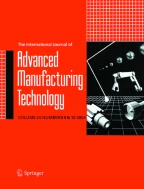Abstract
Currently, design and machining features diverge in meaning, even when they are interpreting the same object. This divergence of feature interpretation provides a venue for research work to reduce the complexity that arises in recognizing interacting machining features. Therefore, this paper demonstrates the recognition of design features with the aim to eventually decompose the interacting machining features. Loop driving recognition links the CAD data directly to the features to be recognized. The first step is to recognize the design features from B-Reps part. Then geometrical reasoning on these design features is employed to convert the design features to its respective machining features. The process of conversion is in fact the process of decomposing the interacting machining features without having to visit the B-Reps data again. The system takes into account the nesting of the design features that causes more interacting machining features to be decomposed. Finally, output data of both design and machining features are then displayed.
Similar content being viewed by others
References
Han JH, Regli WC, Pratt M (2000) Manufacturing feature recognition from solid models: a status report. IEEE Trans Robot Autom 16:782–796. doi:10.1109/70.897789
Joshi S, Chang TC (1988) Graph based heuristics for recognition of machine features from a 3D solid model. Comput-Aided Des 20:58–66. doi:10.1016/0010-4485(88)90050-4
Ibrahim RN, McCormack AD (2005) Robustness and generality issues of feature recognition for CNC machining. Inter J Adv Manuf Technol 25:705–713. doi:10.1007/s00170-003-1929-y
Rahmani K, Arezoo B (2006) Boundary analysis and geometric completion for recognition of interacting machining features. Comput-Aided Des 38:845–856. doi:10.1016/j.cad.2006.04.015
Venuvinod PK, Yuen CF (1994) Efficient automated geometric feature recognition through feature coding. Ann CIRP 43:413–416. doi:10.1016/S0007-8506(07)62242-2
Ismail N, Abu Bakar N, Juri AH (2002) Feature recognition patterns for form features using boundary representation models. Int J Adv Manuf Technol 20:553–556. doi:10.1007/s001700200190
Arivazhagan A, Mehta NK, Jain PK (2008) Development of a feature recognition module for tapered and curved base features. Int J Adv Manuf Technol 39:319–332. doi:10.1007/s00170-007-1212-8
Meeran S, Zulkifli AH (2002) Recognition of simple and complex interacting non-orthogonal features. Pattern Recognit 35:2341–2353. doi:10.1016/S0031-3203(01)00223-0
Chakraborty S, Basu A (2006) Retrieval of machining information from feature patterns using artificial neural networks. Int J Adv Manuf Technol 27:781–787. doi:10.1007/s00170-004-2254-9
Sunil VB, Pande SS (2009) Automatic recognition of machining features using artificial neural networks. Int J Adv Manuf Technol 41:932–947. doi:10.1007/s00170-008-1536-z
Ranjan R, Kumar N, Pandey RK, Tiwari MK (2005) Automatic recognition of machining features from a solid model using the 2D feature pattern. Int J Adv Manuf Technol 26:861–869. doi:10.1007/s00170-003-2059-2
Chen ZM, Gao SM, Li WD (2007) An approach to incremental feature model conversion. Int J Adv Manuf Technol 32:99–108. doi:10.1007/s00170-005-0316-2
Hayasi MT, Asiabanpour B (2009) Extraction of manufacturing information from design-by-feature solid model through feature recognition. Int J Adv Manuf Technol 44:1191–1203. doi:10.1007/s00170-008-1922-6
Sormaz DN, Tennety C (2010) Recognition of interacting volumetric features using 2D hints. Assem Autom 30:131–141. doi:10.1108/01445151011029763
Author information
Authors and Affiliations
Corresponding author
Rights and permissions
About this article
Cite this article
Zheng, Y., Mohd Taib, J. & Tap, M.M. Decomposition of interacting machining features based on the reasoning on the design features. Int J Adv Manuf Technol 58, 359–377 (2012). https://doi.org/10.1007/s00170-011-3385-4
Received:
Accepted:
Published:
Issue Date:
DOI: https://doi.org/10.1007/s00170-011-3385-4
